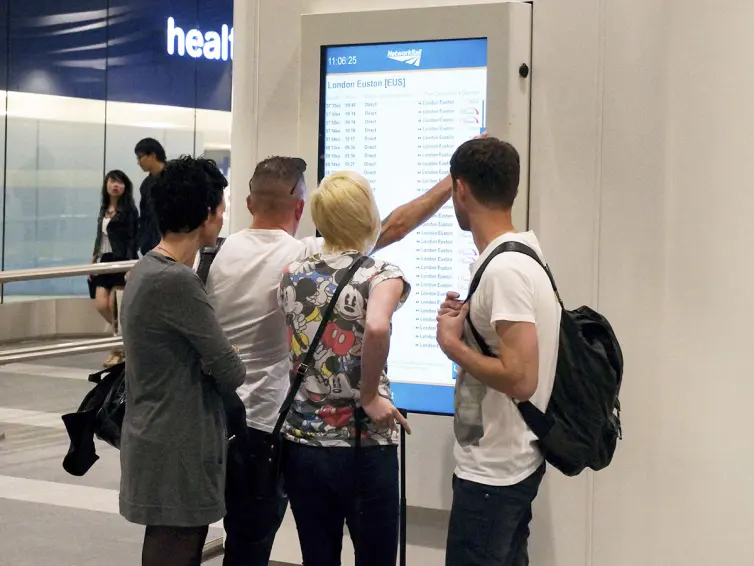Giant interactive passenger information displays at Birmingham New Street Station
- Aug 14, 2018
- Rail
Designing, installing, delivering and supporting a new interactive passenger information display system at Birmingham New Street train station.
Introduction
In April 2013, Birmingham New Street unveiled the first phase of a major redevelopment project to transform the station into a modern technologically advanced transport hub. A fresh approach to transportation revealed a station built for the future, with the final phase finished in the Autumn of 2015. Birmingham New Street Station is used by 140,000 passengers every day. This major redevelopment has been initiated to create a world-class station, a brighter, clearer and more enjoyable space with improved facilities using the latest in technology to enhance passenger journeys. As part of a collaborative systems integration project, L.B. Foster Netpractise were commissioned to design, install, deliver and support a new interactive passenger information display system.
Approach
An intricate and complex project, L.B. Foster Netpractise and partners approached the task by conducting a series of workshops with all local train operators to clearly understand the business needs and technical data requirements of all parties involved. Netpractise then developed the new media solution using in-house technical expertise to implement their unique software Digital Pro Media (DPM) to meet the brief.
Solution
At the time of the launch of phase one on 28th April 2013, the passenger has a wealth of up to the minute information at his fingertips by simply touching the screen to reveal a menu designed around the needs of a typical traveller. This initial phase includes finding ‘the next direct train to’, live departure times, live arrival times, Birmingham New Street train times, a station map and a city map.
‘The next direct train to.’ – the passenger either selects from the list of most popular destinations or manually types in the station of their choice. The moment they start typing the system displays all the stations beginning with the letters typed. The software includes a built in complex word filtering to mitigate against any offensive words or phrases being left on screen by users. The next screen displays a clear list of the train times, destination, platform number, the latest estimated departure time and train operator logo.
Live departures – provides a list displaying the train departure times, destinations, platform numbers, latest estimated departure time and operator in time order
Live arrivals – provides a list displaying the train arrival times, destinations, platform numbers, latest estimated arrival time and operator in time order
New Street train times – the passenger selects a destination from the list of most popular or manually types in the station of their choice and the screen displays a screen layout with train operating company (TOC) logos and detailed service information (including a pop-up legend). QR codes for each TOC enable the user to take away the information they require, using their smartphone.
Station map – shows the passenger a colour coded map of the station including current location and areas such as toilets, tickets, seating areas and retail outlets. The passenger can touch the screen to zoom in and out of the map as needed.
City map – a comprehensive street map of the city centre with the ability to zoom in and out as required.
In addition to the display of relevant passenger information the screen includes a ‘flip’ function, this means that the system is compliant with DDA (Disability Discrimination Act) regulations with no portion of the screen more than 1.4 metres above floor level. The system has also passed human factors testing, delivered by third parties to ensure its usability. Included in the criteria: intuitive, logical, plain English, common language, international symbols.
Results
The second phase of the project due to launch in 2015, will bring the system to life for the consumer by including an interactive map, full journey planner, increased real-time information, bus and further travel information. On completion, the station will have 17 touch screen points located in key locations on the platforms and concourse. All locations were carefully selected on the basis of pedflow (pedestrian) analysis, expected dwell times at the touchscreens and reviewed with the station operator to confirm with the station operational strategy.
Intuitive and simple menu systems enable passengers to select relevant information in seconds, reducing the inconvenience of approaching station staff or searching on a smartphone device. The system eliminates the need to plan journeys in advance and provides flexibility to change plans at a moment’s notice. In addition, passengers no longer need to carry hard copy timetables which often present out of date information.
It also increases customer security as smartphones can be left securely in bags or pockets. The system enables the rail operator to provide direct, up to the second train information to passengers in a user-friendly, speedy, innovative way whilst maintaining their brand identity. The scrolling banner enables additional information to be tailored to the specific needs of that day. Allowing the passengers to independently and proactively find information enables the rail operator to utilise the skills of station personnel more effectively.
The system improves the flow of passengers moving through the concourse area by reducing the number of passengers standing still in order to scan the numerous information display screens. Increased passenger flow leads to improved passenger safety and security.
Netpractise select best of breed audio-visual hardware from the world’s leading manufacturers to ensure the highest quality displays. Installing durable, robust equipment ensures a long product lifecycle which reduces the overall lifetime cost of the installation. The Netpractise DPM software platform enables regular updates to timetable and service information to be deployed without major expense. This flexibility means that future phases of the touchscreen roll-out will include information from other stakeholders in the project, such as Centro and Birmingham City Council.



